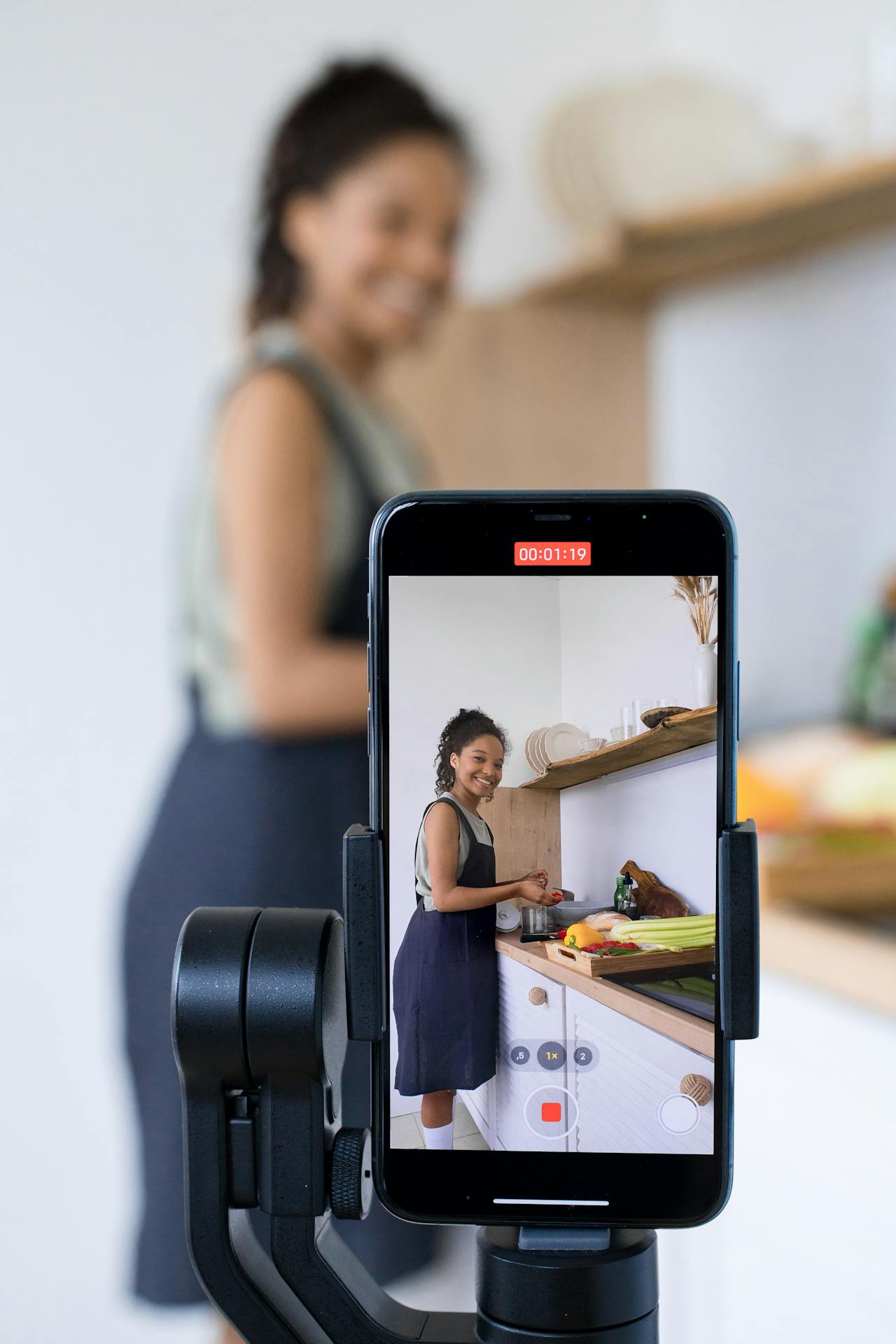Social media marketing is incomplete without influencer marketing. It lets you reach your target audience instantly and this makes it better than social media advertising – in most cases.
However, most businesses and marketers don’t do it right and fail to get the expected results from influencer marketing.
I have listed the best techniques and innovative influencer marketing strategies that have worked for businesses of all sizes. Implementing these techniques will help you exponentially increase ROI.
What is Influencer Marketing?
It is a type of social media marketing where influencers promote your products to their followers. These people have an influence on their followers and they often control their buying power. For example, if Scarlet Johnson recommends something to her followers on her Instagram account, her followers will buy it – that’s influencer marketing.
An influencer is any person who influences a group of people. This doesn’t necessarily include celebrities or famous people. A person who has 200 engaged followers on TikTok is also an influencer.
Here’s an example of an influencer marketing post:
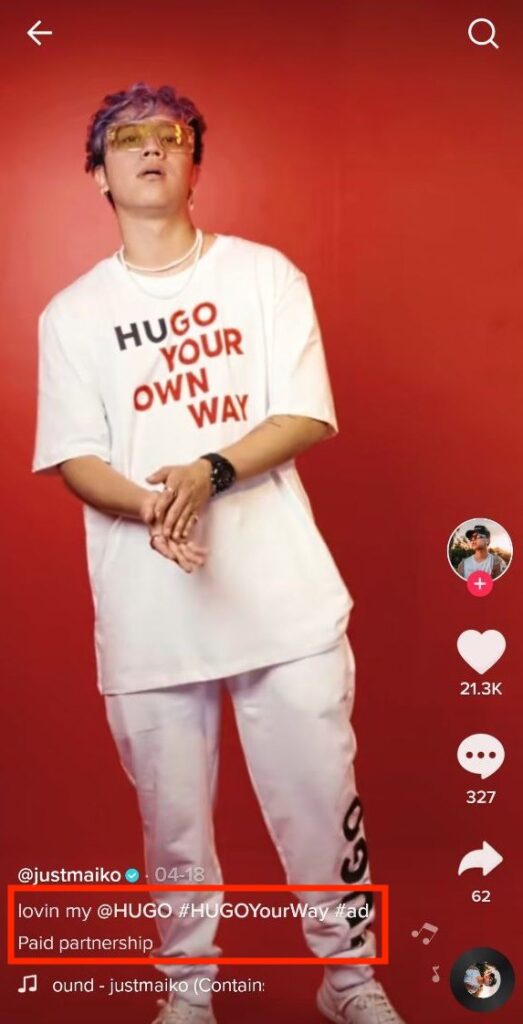
The influencers are paid by the brand for recommending, sharing, or endorsing a product or brand. This makes it a win-win strategy. The brand boosts its reach by connecting to new potential customers and the influencers get paid for publishing new posts (which they do anyway).
Research shows that 72% of Gen Z and millennials follow influencers on social media and 50% of millennials trust product recommendations from influencers. As much as 33% of Gen Z-ers have purchased a product based on the recommendation of an influencer.
This is a reason why 92% of marketers rate influencer marketing as an effective form of marketing. It works exceptionally well when done right.
Influencer Marketing Strategies for Exponential Growth
Doing influencer marketing right is essential for success. Here’s a list of the best influencer marketing strategies and techniques that you should stick with for business growth:
1. Use different types of influencer marketing campaigns
You need to create and use multiple influencer marketing campaigns instead of relying on a few. You can choose from a wide range of different types of campaigns:
- Affiliate marketing
- Collaborations
- Giveaways
- Brand ambassador
- Sponsored content
- Micro-influencers
- Nano influencers
- Discount codes
- Social media event
- Takeover.
Sticking with one or a few campaign types restricts your reach. For example, if you figured out that unboxing videos shared by an influencer work exceptionally well in terms of engagement and conversions and you only focus on such videos, it’ll limit your reach in two ways:
- You are targeting a buyer persona that’s interested in unboxing videos or video content only
- You will end up working with similar types of influencers.
Having multiple types of campaigns with different influencers diversifies your campaigns. Research shows that most companies work with 10 or more influencers while some businesses engage more than 1000 influencers at a given time.

Dunkin’ used a multi-layered influencer marketing campaign with TikToker Charli D’Amelio. It included:
- Combined contest run by Charli and Dunkin’
- Posts by Charli on her TikTok account where she consumes Dunkin’ products
- Dunkin’ named two drinks after Charli to attract her 151 million followers to buy those drinks.

A single campaign isn’t usually the best option even if it works exceptionally well. You have to get out of your comfort zone and try other campaigns. You never know you might be one step away from the most profitable campaign for your business.
2. Narrow down as much as you can
Influencer marketing has become too mainstream. Celebrities and big names are too expensive and often work with multiple brands at a given time. Most small and mid-sized businesses can’t afford big influencers.
This is a reason you should switch to micro and nano influencers who have the highest engagement rates and are quite affordable. A study reported that 73% of the influencers have between 1K to 15K followers:

Influencers having 1K to 10K followers have an average engagement rate of 2.53% which tops all other types of influencers:

This is because nano influencers give you access to a specific group of people who have similar needs and are highly engaged as opposed to a celebrity’s followers who aren’t as engaged and might have diverse needs.
For example, think of a doctor who runs his local clinic and actively posts on Instagram about men’s health issues. His followers will be a few thousand but they’ll be highly engaged with common needs. His followers will be men who are interested in men’s health advice or products.
If you sell a men’s health product that resonates with the doctor, you’ll make a great fit.
Another benefit of using nano influencers is that most of them don’t actively promote products because they (usually) don’t consider themselves influencers. Their audience sees fewer promotions and when they see one, they are more likely to respond positively as opposed to an influencer who shares 1-2 sponsored posts every single day.
How to find nano influencers?
You have to manually search these influencers as most of them aren’t registered with influencer marketing platforms. Use keywords and hashtags to find highly relevant nano or micro thought leaders in a specific niche.
Focused research will reveal a lot of hidden gems.
3. Reach vs engagement
Every influencer campaign requires a selection between reach and engagement. You have to decide whether you want to go with the number of followers or the engagement rate of the influencer.
It is highly unlikely to get both from a single influencer because, as mentioned above, nano influencers have limited reach but high engagement while mega macro influencers have massive reach with limited engagement:
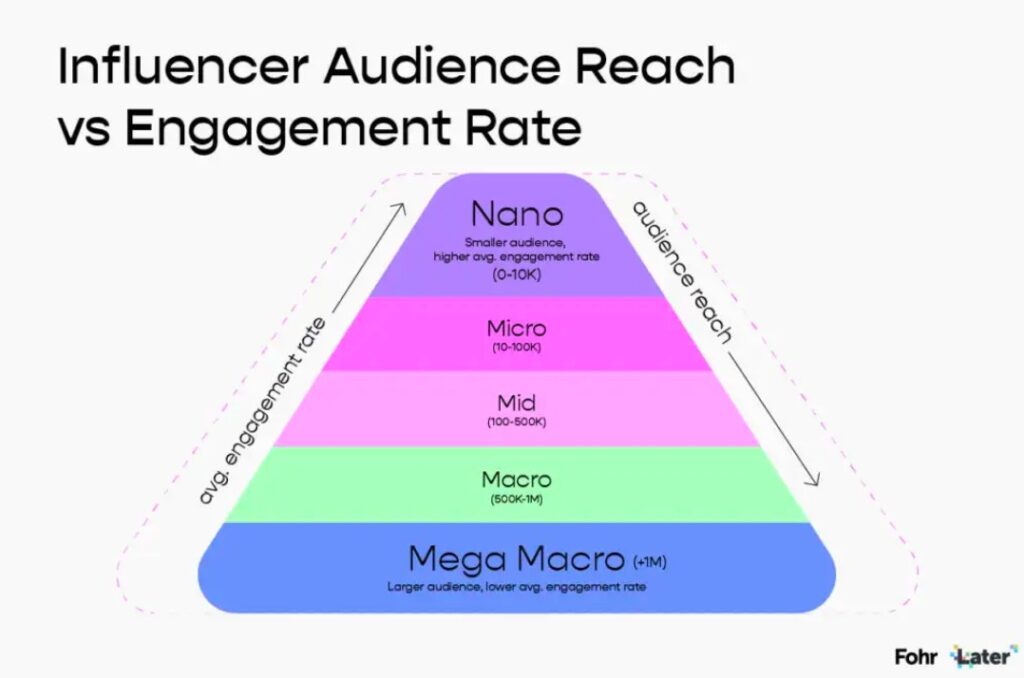
Here’s how sponsored post engagement varies between nano and macro influencers:
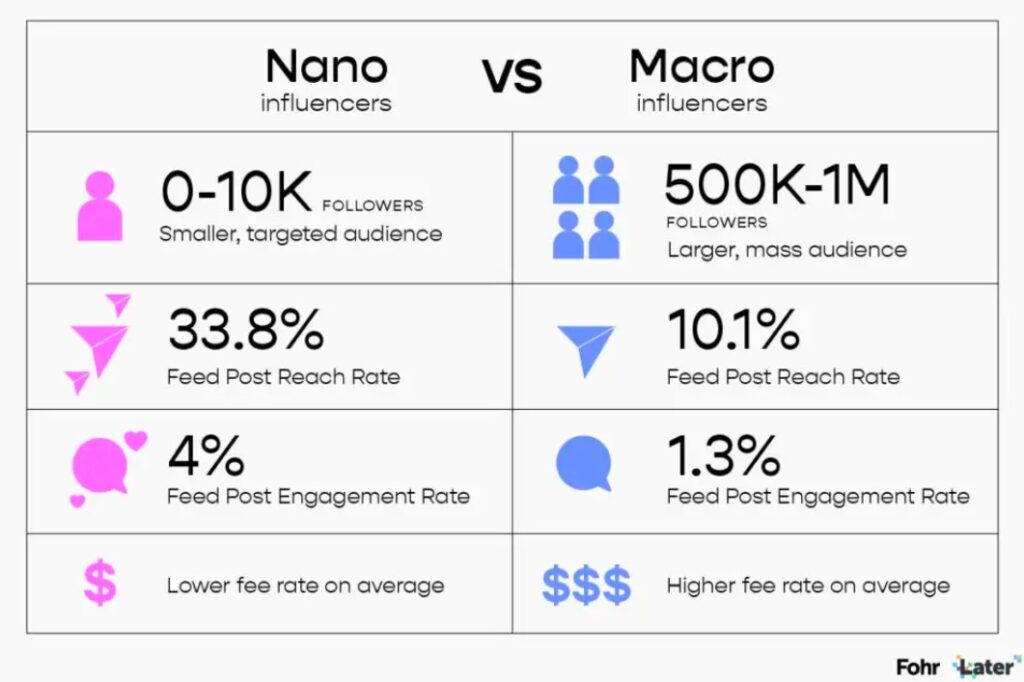
You have to decide what you prefer and this should derive from the campaign objective. What exactly do you want to achieve from the influencer marketing campaign? If you want hyper-personalization and targeted conversation, go with engagement. And if your goal is to boost brand awareness and reach more eyeballs, go for followers.
If you are unsure or would rather need a mix of both, go with mid-sized influencers who have between 100K to 500K followers as they offer both reach and engagement.
Consider the following factors when deciding between reach and engagement:
- Marketing objective: Mass marketing or personalized conversations
- Targeting: Broad audience or highly focused audience
- Budget: High or low.
The decision isn’t as simple as it seems. This is a reason why it’s a good idea to work with multiple influencers and run different influencer marketing campaigns for diversification.
4. Appropriate budget allocation
Influencer marketing is expensive. Proper budget allocation is a must or you might end up overspending quite quickly.
The average starting cost of an influencer marketing campaign or a single post is under $1,000 and it can go as high as $1 million and more in the case of mega influencers:

You need to set a maximum budget per campaign to keep things controlled. This calls for setting clear objectives for the campaign and then allocating the budget to meet them.
The actual cost depends on several factors and might not always be clear upfront. Here’s a list of the major variables that play a role in how much an influencer will charge you:
- Social media network. Instagram, for instance, is quite expensive compared to other networks
- Influencer reach and engagement numbers. High engagement and more followers will lead to high-cost
- Industry and niche. Some niches are quite expensive than others such as fitness and health
- Campaign type. A single one-off engagement will be cheaper as compared to an exclusive long-term contract
- Content type. A Stories post on Instagram is cheaper as compared to a permanent post.
So, what’s an estimated budget per campaign?
It depends.
Research shows that most companies spend less than $10K annually on influencer marketing followed by brands that spend between $10K and $50K per annum:

With $10K per year, you get $833 per month and can run 1-2 campaigns with nano or micro influencers with this budget. That’s what most businesses do.
While it’s not impossible to do influencer marketing with small budgets, you find your hands tied. But it works.
5. Choose the right platform
Not all social media networks perform equally well for influencer marketing. Selecting the right influencer isn’t enough, you have to pick the most suitable social platform.
The right social network is one that aligns with your campaign objectives.
For example, if your objective is to target a specific buyer persona, you need to use a platform that the persona uses. Or if you want to reach a new untapped audience, choose a network where you had zero presence in the past.
Generally, Instagram tops the list with over $2.2 billion expected spending in 2024 by US companies followed by TikTok at $1.2 billion and YouTube at $1 billion:

There isn’t a silver bullet and choosing the right social site requires homework.
For example, for brand awareness and reach campaigns, Instagram is your best bet. YouTube is suitable if you run a video campaign and TikTok is ideal for targeting Gen Z.
Consider the following factors to pick the right social site:
- Campaign objective: The social app should align with your influencer marketing objective and should help you achieve your purpose
- Budget: Low-budget campaigns should stick with regular platforms that don’t cost too much
- Target audience: Each platform has a different audience type that you need to consider before finalizing the social platform
- Buyer persona relevance: The social platform must be relevant to at least one buyer persona that you target. Running a campaign on a network where your personas don’t exist might not work well (unless it’s experimental)
- Content and campaign type: Not all campaigns and content work for all sites. If you have existing content that you want to promote via an influencer, you need to match the content with the platform.
Your decision to choose a platform must be data-driven. Look at the analytics and do more of what has already worked for you in the past.
6. Use manual outreach
This might sound counterintuitive but it works.
Finding influencers manually without the use of any influencer marketing tool has some major benefits:
- You can run campaigns at a quite low cost because influencers that aren’t listed on a dedicated platform normally underquote
- These influencers have high engagement because they don’t publish too many sponsored posts
- You can find and connect with new influencers that are unknown to most of your competitors and you get the first-mover advantage.
Influencers who are listed on multiple influencer marketing platforms have strict guidelines and fixed budgets. It isn’t easy to bargain or make them work differently than they normally do. This makes your campaign generic and it is likely to get lost on the influencer’s feed like any other sponsored post.
Your brand, content, and product have little room to stand out and this negatively impacts your brand image and reputation.
Finding the right influencer who is a perfect fit for your brand isn’t a piece of cake. There are numerous ways besides dedicated platforms such as hashtag search, using Google search, screening your followers, competitor follower scanning, and others:
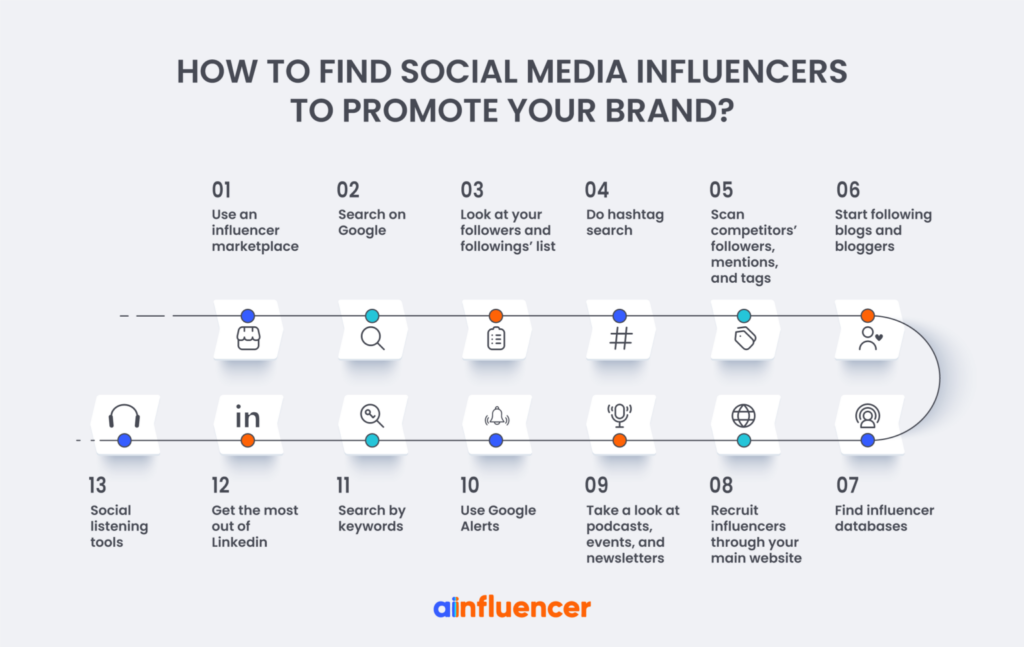
It seems to be a lot of work to find influencers manually, and it indeed is, but it pays off. This is ideal for long-term collaborations and ambassador campaigns.
7. Enable tracking and attribution
Tracking performance and proving the ROI of influencer marketing campaigns is a big challenge.
According to a survey, measuring influencer marketing ROI is the biggest challenge that marketers face:
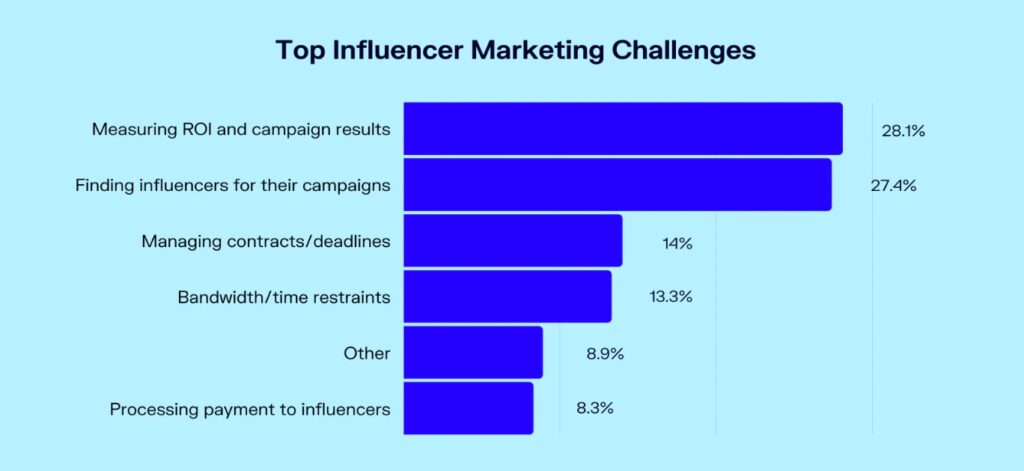
One major reason why it’s hard to measure ROI is that influencer marketing is mostly tracked via qualitative metrics such as engagement, brand awareness, reach, etc. It is nearly impossible to measure brand awareness or actual engagement of an influencer marketing campaign.
There are two ways to fix this issue:
- Create campaigns with quantitative metrics such as clicks, impressions, referral traffic, sales, etc. Quantitative metrics can be tracked and measured easily with little to no effort.
- Use an attribution tool that lets you track the entire customer journey end-to-end and measures actual campaign performance and ROI by attribution modeling.
An attribution tool tracks all the interactions of a customer with your company and credits each touchpoint based on a model such as linear or time decay. This helps you credit the most appropriate touchpoint and you can measure the impact and ROI of each interaction at a granular level.
Here’s an example of a linear attribution model:

And here’s how the position-based attribution model works:

A tool like Ruler Analytics can help you set up attribution models and track the customer journey. You can set up attribution models in Google Analytics too free of cost.
You need to set up an attribution model to track and measure influencer marketing. This is the best way to figure out what influencer marketing campaigns and influencers are actually making a solid contribution to sales and revenue.
In the absence of a robust tracking system, you only track metrics that mean nothing. And it gets hard to identify the right influencers for repeat campaigns.
Switch to data-driven influencer marketing for best results.
8. Enforce branding
Influencers want creative freedom so they can publish content that their audience is used to. And that content might be against your brand guidelines.
It gets challenging for businesses to enforce and maintain branding for influencer-published content. You pay for content creation but it doesn’t adhere to your branding style. It eventually tarnishes your brand as your target audience is bombarded with inconsistent branded content.
This is another reason why you should prefer nano and micro-influencers as they easily follow your branding style as they don’t get a lot of opportunities. Mega influencers, on the other hand, are very picky and have their own guidelines that you have to meet.
You need a brand style guide so your team and business partners (including influencers) know and follow it. It is an absolute must when working with influencers as it helps you maintain brand identity and keep influencer campaigns consistent. It has your brand logo, color palette, voice, typography, image guidelines, and other details that make your brand distinct and stand out from the crowd.
Walmart has a detailed creative marketing brand guide that covers all the aspects of its branding:
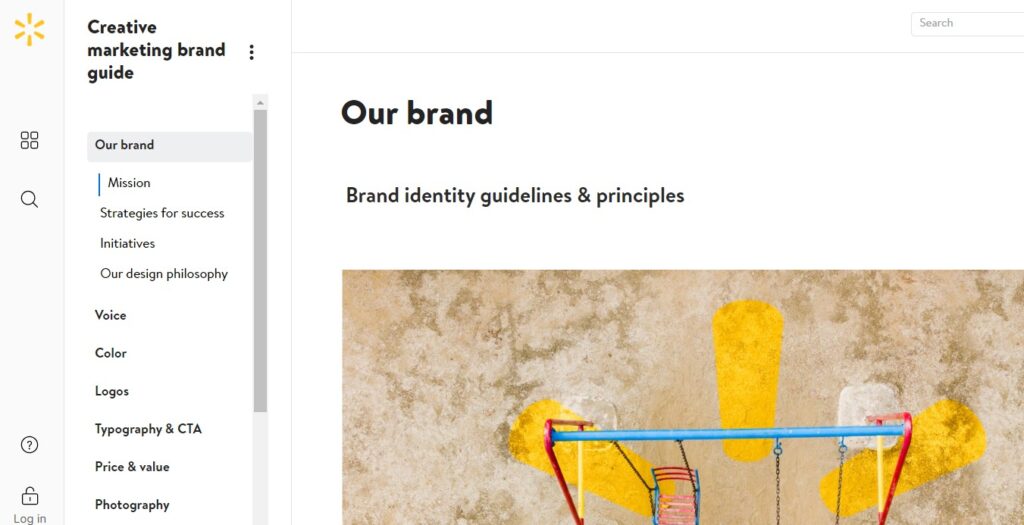
You can create a style guide using a template in a design tool such as Canva. It’ll help you a lot in the long run.
Having a style guide isn’t enough. You have to do much more than that to protect your brand voice. Follow these tips to maintain your brand’s identity when working with influencers:
- Choose the right influencer whose vision and philosophy align with your business. Your brand’s identity is more likely to enhance when you work with like-minded influencers
- Have a formal contract with the influencer, even if it is a single post, and ensure that you have clearly defined terms listed in the contract
- Stick with nano and micro-influencers as they are more likely to follow your style guide without hesitation
- Create content in-house and ask influencers to share it with their audience. This gives you maximum control
- When influencers create content themselves, make sure you review it before it goes live
- Work long-term with influencers as it persuades them to follow your guidelines because nobody likes rejecting a long-term, repeat client.
Grow Your Business with Influencer Marketing
The way people’s interest in social media is increasing, we’ll continue to see an increase in the number of influencers. Gen Z and Alpha use social platforms more than search engines. Research shows that 74% of Gen Z uses TikTok specifically to search for what they are looking for while 51% of users exclusively use TikTok over Google search.
Not using influencer marketing isn’t an option.
You have to use it.
If you aren’t investing in influencer marketing already, it’s time to allocate a decent marketing budget to it. If you are already doing it, increase your budget.
It is the best form of marketing that has unmatched potential.
Featured Image: Pexels


